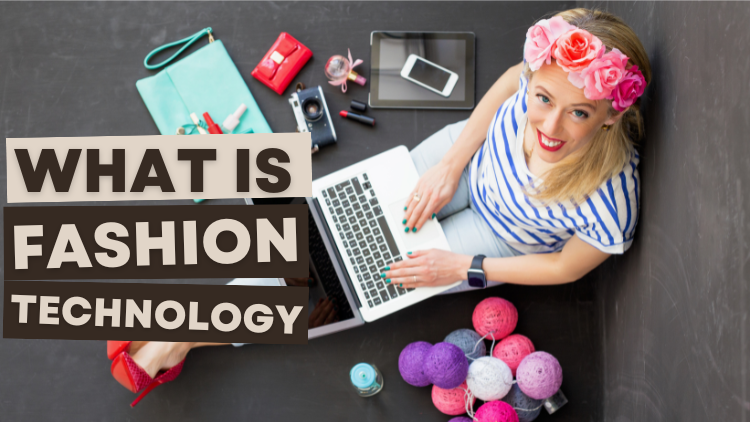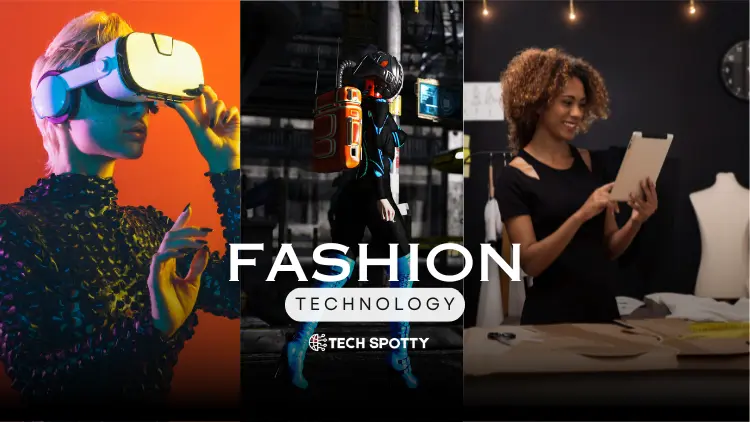Fashion Technology | How Technology is Shaping the Future of Clothing
Fashion technology plays an important role in the clothing industry by changing how we design, make, and interact with fashion products. It helps designers use computer-aided design (CAD) and manufacturing (CAM) to create unique designs and patterns more easily and accurately. This makes the design process faster and gives designers an advantage in the competitive fashion world.
In production, technology has brought big improvements through machines and automation. This allows for faster and cheaper production. But it’s not just about machines; innovations like wearable technology and smart fabrics add exciting new features to clothing, blending fashion with practical uses like health tracking.
In online shopping, virtual tryon tools let shoppers see how clothes will look on them before buying, making shopping easier and more fun. Overall, fashion technology is shaping the future of fashion by making it more accessible and enjoyable for everyone, helping both manufacturers and consumers. The combination of fashion and technology is creating exciting new developments that continue to evolve.
What is Fashion Technology?

The application of new technologies and techniques to improve the fashion industry is known as fashion technology. It combines clothing with technology to improve design, production, and wear. This can include:
- Smart fabrics that can change color or track health.
- Wearable gadgets like smartwatches that blend fashion with function.
- Virtual tryons that let people see how clothes will look without needing to wear them physically.
- Advanced machines that help make clothes faster and with less waste.
The Role of Technology in 3D Printing
3D printing is changing the fashion industry by increasing the many benefits of clothing for individuals worldwide. Using a combination of materials in a single layer, this technique allows designers and manufacturers to produce nearly any design they can dream of. Therefore, they may create a large variety of textiles with various qualities suited to certain client requirements.
However, 3D printing is not simply useful for textiles; it can also be used to create fashion items that are not textiles. It helps fashion businesses develop clothing that perfectly fits all body shapes and sizes while allowing designers to show their creativity.
Here are some key benefits of 3D printing in fashion:
Custom Fit Clothing
3D printing can create garments that fit individual customers perfectly, reducing fabric waste and improving comfort.
Complex Designs
With 3D printing, designers can make complex patterns and fabric structures that go beyond what traditional methods allow.
Fast Prototyping
3D printing makes it easy for designers to quickly test and improve their new ideas, speeding up the design process.
Sustainability
One of the biggest advantages of 3D printing is reducing fabric waste by using exact amounts of material. Some companies also use recycled plastics and other advanced materials, making fashion more eco-friendly.
Smart Clothing
3D printing can create garments with built-in technology, like sensors, to meet functional needs in innovative ways.
The Role of Technology from CAD to Machine Learning
The fashion design process has seen significant changes due to the development of computer science and information technology, which has aided in the fast expansion of the clothing business. Computer-aided tools have given designers the power to turn their ideas into reality. Modern fashion has reached new heights because of the usage of programs like Computer-Aided Design (CAD) and Computer-Aided Manufacturing (CAM). Artificial Intelligence (AI) and other technologies improve the development of new ideas and styles while saving time and money.

The combination of CAD and machine learning has a particularly significant effect on the fashion business, changing how designs are created, how clothing is made, and how consumers view fashion. Here are some key areas where it has made a difference:
Designing and Prototyping:
CAD-CAM software has changed the way designers create clothing. They can make and adjust patterns virtually, using tools like Adobe Illustrator, Photoshop, and CorelDRAW. Machine Learning helps by analyzing data to predict trends and customer preferences, allowing designers to make unique and market-friendly designs.
Pattern Designing and Cutting:
CAD tools help digitize and improve patterns with great accuracy, leading to more efficient cutting. Machine Learning uses past data to improve pattern making, reduce fabric waste, cut costs, and boost the productivity of design and cutting teams.
Inventory Management:
Machine Learning is important for predicting how much stock is needed. It helps companies plan production and manage inventory better. For example, Zara uses machine learning to manage its stock efficiently, allowing it to adapt quickly to changing customer needs.
The Role of Technology in Digital Clothing
The way that new technological developments are influencing and reshaping fashion, attire, and style is referred to as fashion technology trends. These trends show the relationship between technological advancements and the change of fashion. Given that the fashion sector is projected to reach a valuation of up to $3.3 trillion by 2030, it is critical to comprehend how technology affects the fashion and style industries.
Social media, digital marketing, visual merchandising, and advanced software greatly aid this change. Customers, particularly younger ones, may easily identify the newest trends and items that suit their wants and tastes, thanks to these technologies. It’s challenging for producers and fashion brands to keep up with creating huge amounts of clothing in a world where trends shift quickly.
Many designers and businesses are using the newest technologies to address manufacturing issues. For example, blockchain, e-commerce, smartphone applications, and other emerging technologies use artificial intelligence (AI) to improve fashion experiences and optimize processes.
The industry is changing quickly due to the combination of fashion and technology, generating creative new trends that will keep shaping fashion and clothing in the future.
Let’s analyze the main developments in technology for fashion technology::
- New Fabrics: The future of fashion will have cool, eco-friendly materials. For example, companies like Modern Meadow make lab-grown leather, meaning no animals are harmed.
- Internet of Things (IoT): Clothes and accessories are now connected to the internet! This means we can have smart clothing and other devices that work with technology.
- Fast Data: Businesses use much information to make changes and improvements and stay ahead quickly.
- Shopping on Phones: Buying clothes and accessories on our phones is easier than ever. We can now use apps, digital wallets, and social media to shop quickly.
- Virtual Reality (VR) and Augmented Reality (AR): These technologies let people try clothes online like in a real store. It’s like trying on outfits without leaving your house!
- Online Design Tools: Tools like Vectr help people design fashion without needing special skills or software. You can create cool designs easily online.
- AI Inventory Management: AI is smart technology that helps stores keep track of their products. It ensures the right items are always available based on what customers want.
Application of AI in the Fashion Industry
AI (Artificial Intelligence) is like a super smart computer that helps the fashion industry in many ways:
- Designing Clothes: AI helps designers develop new ideas and suggests popular patterns and styles.
- Predicting Trends: AI can study lots of data to guess what styles will be popular in the future, so companies can make clothes that people will like.
- Better Shopping: AI helps online stores show you clothes you might like based on what you’ve looked at before.
- Smart Inventory: AI helps fashion stores track how much clothing they have, ensuring they have the right amount of stock for their customers.
- Custom Clothes: Some brands use AI to make clothes that fit people perfectly by taking their measurements through apps.
Challenges and the Future of Fashion Technology
Fashion technology is growing quickly, but it also faces some challenges:
- High Costs: Advanced technology like 3D printing, AI, and smart fabrics can be expensive, making it harder for smaller brands to use.
- Sustainability Issues: While new tech can reduce waste, some materials and processes are still not eco-friendly. Making fashion both high-tech and good for the planet is a challenge.
- Learning New Skills: Designers and workers must know how to use new CAD software and AI tools. This can take time and effort.
- Data Privacy: As fashion brands collect more customer data through online shopping and smart clothing, keeping that data safe is very important.
Despite these challenges, the future of fashion technology looks exciting. We will see:
- More Eco-Friendly Innovations: New materials and methods will continue to reduce waste and make fashion greener.
- Personalized Shopping: AI will help create even more customized clothing and shopping experiences.
- Virtual Fashion: Virtual reality (VR) and augmented reality (AR) will let people try on clothes without ever leaving home.
Bottom line
Fashion technology is changing how we design, produce, and wear clothes. With the help of tools like AI, 3D printing, and smart fabrics, the fashion industry is becoming more creative, efficient, and sustainable. Although there are challenges like high costs and learning new skills, the future of fashion technology looks exciting. We can expect more eco-friendly innovations, personalized shopping, and virtual fashion experiences. As technology continues to advance, fashion will keep evolving in amazing ways.
FAQs
Q1. What is fashion technology?
Fashion technology combines new tools and techniques to improve how clothes are designed, made, and sold. It includes things like smart fabrics and online shopping tools.
Q2. How does AI help in fashion?
AI helps designers create new styles, predicts future trends, suggests clothes you might like, and allows stores to keep track of their inventory.
Q3. What is 3D printing in fashion?
3D printing allows designers to create custom clothes and accessories using special machines that build items layer by layer. This makes it easier to create unique designs.
Q4. What are smart fabrics?
Smart fabrics are special materials that can change color, track health, or respond to the environment. They make clothing more functional and innovative.
Q5. What are the challenges of fashion technology?
Some challenges include high costs for new tech, the need for eco-friendly materials, learning new skills, and keeping customer data safe.

